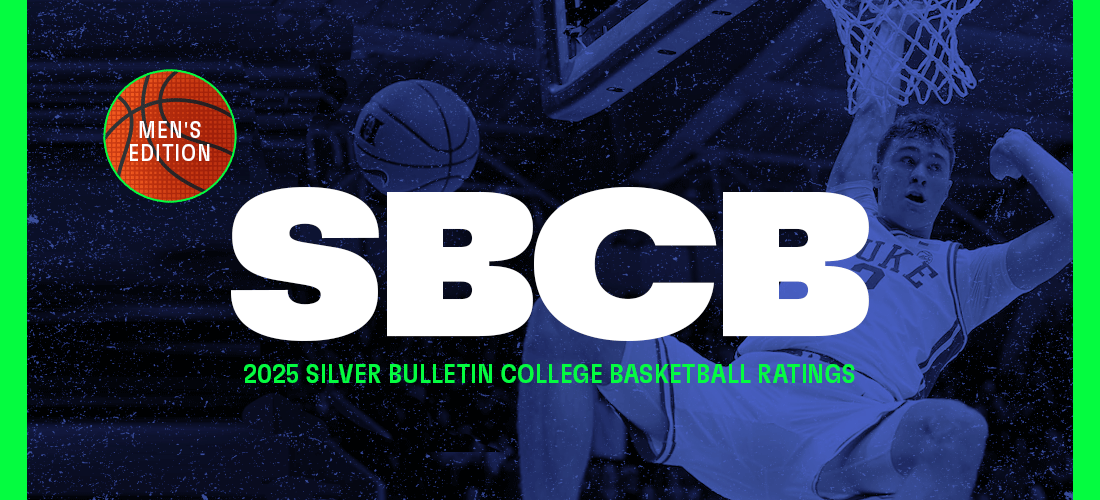Silver Bulletin College Basketball (SBCB) ratings 🏀
Our Elo-derived ratings for all 364 men's Division I NCAA basketball teams.
🕒 The latest
April 8, 2025. These are our season-ending women’s SBCB ratings for 2024-25! They’ll be back next season! Congratulations to Florida for winning the national title; they’re also the best team in both versions of our ratings. For the women’s version of SBCB ratings, see here.
Welcome to the homepage for the men’s edition of our Silver Bulletin College Basketball (SBCB) ratings. It will be updated roughly once per day, either in the evening or the morning after the full slate of games is played.1 If you’re viewing this in the Substack app or your email client, you may want to click over to the web version to see the latest data.
There are two versions of SBCB: a “pure” version that essentially only accounts for performance on the court and a “Bayesian” version that also factors in human ratings — specifically preseason ratings in the AP and Coaches polls. For instance, Kansas has a considerably higher rating in the Bayesian version because they were the preseason #1 — although their performance hasn’t lived up to their advance billing. Despite this, the Bayesian version generally yields more accurate predictions of upcoming games. Here is the current top 10 in each system:
The pure version of SBCB is free for all readers, while the Bayesian version requires a paid subscription. Paid subscribers will also get a spreadsheet showing how to translate Elo ratings to win probabilities and projected margins of victory (i.e. point spreads). And they’ll get full access to our men’s and women’s NCAA tournament forecasts once those launch, which blend SBCB with other ratings.
SBCB is an Elo-based rating system, though with many enhancements and modifications. For a more complete methodological description, see here. I’ll just go over the basics in a few bullet points.
The most important factor in Elo is simply winning, especially against strong opponents. A team can never lose Elo status in any game it wins — but it gains far more credit for winning games as an underdog.
However, our formula also accounts for margin of victory and home court.
Home-court advantage consists of two factors. First, a rolling score specific to each school indicating its tendency to overperform or underperform its Elo rating in home games — teams like Purdue and Duke that are reputed to have substantial home-court advantages often do. Second, a travel distance factor.2
SBCB ratings never reset to zero. Games from previous seasons have some influence. This adds predictive value since the college basketball season is relatively short, though it may make SBCB less appropriate for comparing tournament resumes based on the current season’s play.
There are some special procedures at the start of each season. In the pure version of SBCB, each team’s rating is reverted toward the mean of its conference. In the Bayesian version, the mean reversion process considers human polls in addition to conference strength. Despite this, SBCB is generally more bullish on mid-major and “minor” conference teams than its competitors.
Although the ratings account for more than 250,000 games (!) going all the way back to the 1949-1950 season3, we’ve made some modifications to reflect the changing nature of the sport. There’s more mean reversion in recent seasons, reflecting higher player turnover. And the travel distance component is lesser because of increasingly luxurious accommodations.
Let’s keep the rest of this simple. Here are the pure SBCB ratings for those of you who don’t want any human-flavored inputs:
And here is the Bayesian version, which should be slightly better for predictions:



